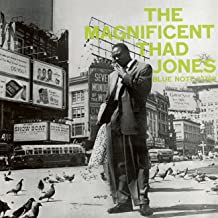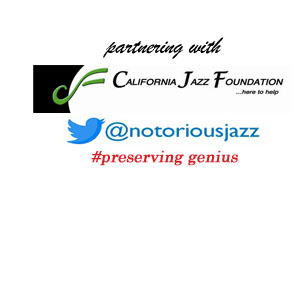
Requisites
The Magnificent Thad Jones | By Eddie CarterMy next entry from the library is the second of three albums released in 1956 by trumpeter, Thad Jones. The Magnificent Thad Jones (Blue Note BLP 1527) finds him in the company of Billy Mitchell on tenor sax, Barry Harris on piano, Percy Heath on bass, and Max Roach on drums. He comes from a musical family, his older brother is pianist Hank Jones and his younger brother, the dynamic drummer, Elvin Jones. Jones also taught himself to play the cornet, and French horn, becoming a professional musician at sixteen. Thad was also a member of some great big bands including Count Basie, Gil Evans, Quincy Jones, and Ernie Wilkins. Jones also led small groups as well and co-led The Jazz Orchestra with drummer Mel Lewis for twelve-years. He led The Danish Radio Big Band and the Count Basie Orchestra for a time after Basie’s death in 1984. His status as an accomplished arranger and composer has given the music world some of the most beautiful compositions ever written including what many consider his masterpiece, A Child Is Born. My copy used in this report is the 2016 Music Matters Jazz Mono audiophile reissue (MMBLP-1527).
April In Paris, written in 1932 by Vernon Duke and E.Y. Harburg begins our five-song journey. It premiered in the Broadway musical Walk a Little Faster that year, later becoming a favorite song among jazz and pop musicians and vocalists. Percy and Max introduce the tune softly, then the front line and piano enter for the melody with Thad dispensing a mellow tone from his horn. Billy makes a brief comment during the opening and ending chorus. Jones opens with a quote from the English nursery rhyme and children’s song, Pop Goes The Weasel. His ensuing verses flow at a relaxing pace into the reprise and fadeout.
Thad’s Billie-Do is a blues characterized by the quintet’s carefree feeling from the brief introduction of the trio into the opening chorus providing a delightful treat of what’s to come. Everyone kicks back individually except Max who provides pleasant brushwork behind each soloist. Jones begins the lead solo with a sweet-toned delivery, then Mitchell conveys a bluesy impression of playful relaxation with a down-home flavor. Harris swings easily on the third reading, then Percy illustrates his rhythmic ingenuity on an abbreviated closer before the quintet takes the song out.
If I Love Again, the 1932 ballad written by Ben Oakland and J.P. Murray ends Side One at an upbeat pace with the quintet delivering high-spirited energy on the melody. Barry opens the soloing with a jubilant performance, then Billy takes over for a vigorously brisk workout. Thad follows with a captivating reading, then Max closes with a clear, crisp attack providing some irresistible musical thrills swinging to the ensemble’s finale.
If Someone Had Told Me is a little-known ballad by Peter DeRose and Charles Tobias that I believe was written in 1952 because the two earliest vocals of the song were released that year. The first was by vocalist Dolores Gray, and the second was done by Sarah Vaughan. The version heard here is a quartet presentation and an attractive feature for Thad who is the only soloist with the trio providing an elegantly lush foundation under him. The trumpeter delivers a performance of beguiling warmth reflecting a bittersweet, poignant moment into a delicately tender finale as good as any you’ve ever heard or will hear.
Side Two closes with Thedia, a cheerfully joyful tune written for and named after Thad’s young daughter. The rhythm section makes a brief introduction for both horns to walk comfortably at an easy beat during the main theme. Billy takes the first solo, establishing a nice momentum in a meticulously conceived and well-executed performance. Barry is next in the spotlight, strolling and swinging to an intriguing beat. Perry grabs and holds the listener’s attention on the third interpretation with two brief choruses that’ll make him or her feel right at home. Thad takes a long, lengthy ride, soaring to the heights on the next statement seamlessly. Max shares the final spot with the leader in several exceptional exchanges ahead of the ensemble’s closing chorus and exit. The sound quality on The Magnificent Thad Jones is positively stunning with an excellent soundstage and tonal balance between the highs, midrange, and bass that transports your sweet spot to the studio hearing the musicians at their best.
The MMJ reissues also include exceptional front and rear covers, high-definition gatefold photos and the pressings by RTI are on 180-gram Virgin Vinyl. If you’re a fan of Hard-Bop or are just discovering Thad Jones, you’ll be delightfully surprised by The Magnificent Thad Jones. It’s jazz at its best and a title I’m certain you’ll enjoy for a very long time! During the fifties, Blue Note employed a sales strategy of giving distinguishing names to some of the artists on its label to spark the public’s interest in their albums and possibly boost their sales. Other examples of this are The Fabulous Fats Navarro, The Amazing Bud Powell, and The Incredible Jimmy Smith. In the cases of the artists listed above, the strategy succeeded beyond their expectations and the names stuck. Debut Records also used this method for The Fabulous Thad Jones in 1954!
~ April in Paris (Verve Records MG V-8012); The Fabulous Thad Jones (Debut Records DLP-12); If Someone Had Told Me (Decca Records 28051), (Columbia 4-39719, 39719) – Source: Discogs.com
~ April in Paris – Source: JazzStandards.com ~ If I Love Again – Source: MusicNotes.com ~ Thad Jones, Pop Goes The Weasel – Source: Wikipedia.org ©2020 by Edward Thomas Carter
More Posts: choice,classic,collectible,collector,history,instrumental,jazz,music,trumpet


